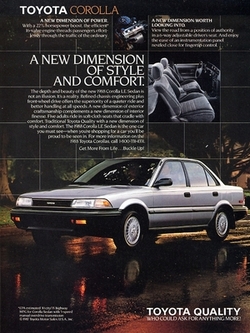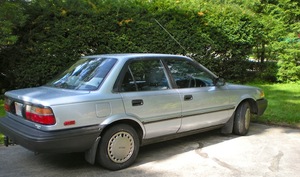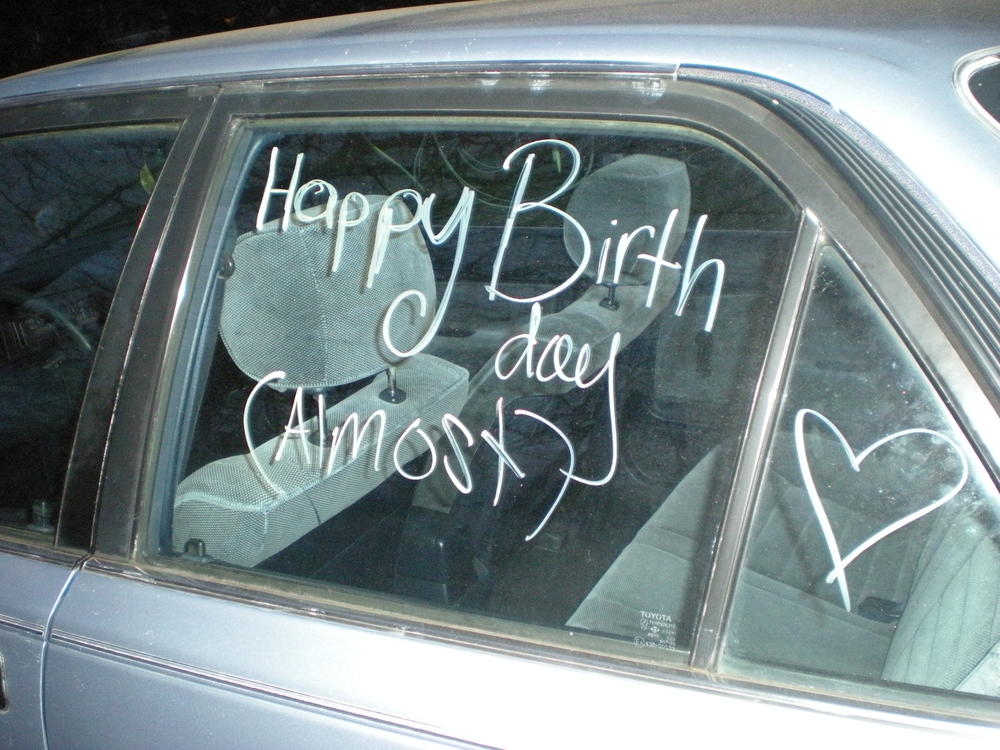To many teenagers, owning a car is a quintessential part of the American dream. A car is freedom, fun, and speed rolled into one machine. Ideally, these tickets to freedom come in sleek, shiny, perfectly polished bodies, with hundreds of horses under the hood. My freedom came in a slightly different package. My package lacked both airbags and anti-lock brakes, and was several years my senior, but nevertheless brought me more happiness than any newer car could have.
 1988 Corolla AdvertisementThe car that would eventually become known as “Cosmo” was born in 1988. It was a powder blue Corolla, with a matching blue cloth interior—a decorative choice only the ‘80s could bless. My aunt, then in her mid twenties, bought the car with little knowledge it would eventually belong to her still unborn niece. She drove it for several years, before selling it my grandfather. My grandfather then sold it to my uncle, who at the time was a college student. He drove it for a decade or so, and once married, sold it back to my grandfather, who continued to drive it for another nine years. Upon getting my license, I searched for a car that was within my price range, as my parents had made it clear that if I wanted a car of my own, I would have to finance the endeavor myself. Unfortunately, I found no cars that I could insure, afford, and buy gas for. My dream was deferred for a year. The past summer however, on a college visit, my mom and I stopped at my grandparents’ house, and I noticed that, as my grandfather is somewhat of a car enthusiast, they had accumulated four cars.
1988 Corolla AdvertisementThe car that would eventually become known as “Cosmo” was born in 1988. It was a powder blue Corolla, with a matching blue cloth interior—a decorative choice only the ‘80s could bless. My aunt, then in her mid twenties, bought the car with little knowledge it would eventually belong to her still unborn niece. She drove it for several years, before selling it my grandfather. My grandfather then sold it to my uncle, who at the time was a college student. He drove it for a decade or so, and once married, sold it back to my grandfather, who continued to drive it for another nine years. Upon getting my license, I searched for a car that was within my price range, as my parents had made it clear that if I wanted a car of my own, I would have to finance the endeavor myself. Unfortunately, I found no cars that I could insure, afford, and buy gas for. My dream was deferred for a year. The past summer however, on a college visit, my mom and I stopped at my grandparents’ house, and I noticed that, as my grandfather is somewhat of a car enthusiast, they had accumulated four cars.
During my search for a car of my own, I racked my brain for relatives or family friends who might have been willing to sell me an old car at a decent price, but came up with no one. Once I saw the Corolla in the driveway however, I had hope. I offered to buy it from my grandfather for eight hundred dollars, but at my grandmother’s eagerness to rid the driveway of what she considered an eyesore, he offered it to me for free. There were only two catches: it was a manual transmission, and we somehow needed to get the car from Delaware to Massachusetts. Both obstacles were eventually overcome. The former with a lot of stalling and swearing, and the latter with an eight-hour family drive in the ancient sub-compact surrounded by SUVs and trucks whizzing by on the New Jersey turnpike.
 For the week following Cosmo’s arrival in our driveway, I meticulously cleaned him, inside and out. It was a labor of love, and as I scrubbed away at the twenty-one years of grime, I began to notice the marks my various family members had left on the car. The back speakers were completely blown out, crackling rhythmically with each song—the damage undoubtedly a relic from my aunt’s early years. The radio was replaced after the original was stolen—a result of my uncle’s years living in the city. The rubber bumper was coated with an odd black paint—an attempt by my grandfather to prevent it from cracking (one of the many “improvements” he had done himself), and the headlights were covered in speckles of the black paint—a testament to his less than perfect eyesight. I was the fourth owner of this car, and I knew I too would leave my mark on it.
For the week following Cosmo’s arrival in our driveway, I meticulously cleaned him, inside and out. It was a labor of love, and as I scrubbed away at the twenty-one years of grime, I began to notice the marks my various family members had left on the car. The back speakers were completely blown out, crackling rhythmically with each song—the damage undoubtedly a relic from my aunt’s early years. The radio was replaced after the original was stolen—a result of my uncle’s years living in the city. The rubber bumper was coated with an odd black paint—an attempt by my grandfather to prevent it from cracking (one of the many “improvements” he had done himself), and the headlights were covered in speckles of the black paint—a testament to his less than perfect eyesight. I was the fourth owner of this car, and I knew I too would leave my mark on it.

Initially, I was slightly ashamed that my car did not match my friends’ cars in quality. The transmission was not the only manual thing in the car. The mirrors, windows, and lights fell into the same category, and people gave me perplexed looks when I asked them to lock their doors when exiting. Some people would not ride with me, as they were convinced—with due cause—that a wheel could pop off or the engine could ignite at any moment. Those who did choose to take their chances, were disconcerted by the lack of shoulder belts in the back, and possibly more so by my cheerful explanation that the backseat is the safest part of the car. I quickly learned to love Cosmo, and all the raised eyebrows that came along with him.
Alas, Cosmo is no longer with us. The twenty-one winters he endured finally took their toll, and his entire framework rusted beyond repair. Owning Cosmo however, taught me lessons beyond the fact that manual lights are in fact manual, and will not turn themselves off; they will continue to shine until the battery is completely dead. The value something holds is a result of the experiences it has undergone, not its original features. It is our imperfections that give us character, and the same holds true for objects. Yes, a five speaker sound system would have been nice, but it was more fun imagining what my aunt could have done in that car to destroy the speakers so thoroughly. A body that was not covered in splatters of bumper paint would certainly have been more handsome, but my grandfather, always an engineer, could never let anything alone, and I would like to think he did save the bumper from cracking.
In turn, it is our experiences with such objects that give our lives value. The first time going to college seemed real was when I put a university sticker in the back window, and my constant struggling with the shifting strengthened a friendship with a friend who had similar problems. I learned to take pride in what I had, and to enjoy something for what it is: the good, the bad, and the quirky. While living life, what we are given is not as important as what we learn from it and how we leave our mark on it. Owning Cosmo prompted me to realize this, and for that I will always remember him fondly, blue interior and all.
Originally from the Boston area, Madeleine Clute is currently studying Cognitive and Computer Science at Carnegie-Mellon University.


